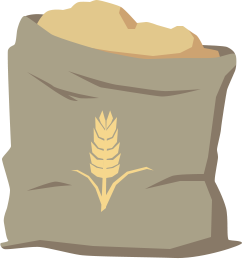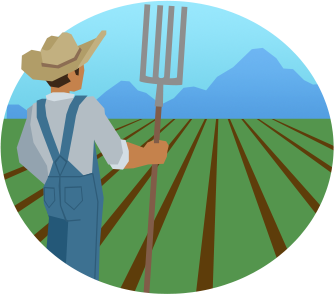FAQ - Croplands
What is climate-smart agriculture?
Climate-smart agriculture (CSA) is an approach that helps agricultural systems to develop sustainable food production under climate change. CSA helps to guide actions needed to reorient agricultural systems towards ensuring food security in a changing climate. It also aims to sustainably increase agricultural productivity while reducing greenhouse gas emissions and increasing resilience and adaptation to climate change.

How can farmers innovate and adapt to a changing climate?
There are multiple ways farmers can innovate and adapt to a changing climate. Some of the promising technologies that can be adopted include the use of more recent crop varieties and species, adjustment in the timing of farm operations, diversified cropping systems, cover cropping, livestock-integrated cropping systems, conservation tillage systems, and more efficient irrigation, fertility, pest, and disease management practices.
How can we increase resilience through improved soil and nutrient management?
First, we need to know that soil is a living system. Healthy soil is like a healthy human being; it can function better when health and nutrition are balanced. Improved management practices that minimize disturbance, increase diversity in crop residue and nutrient inputs, and provide a consistent environment for microbial proliferation can accumulate more soil organic matter, which is a storehouse of nutrients. Soil organic matter also increases water holding capacity, pH buffering, soil aggregation and aggregate stability, and infiltration. With these positive changes, soils can function better under biotic (insect pests and diseases) and abiotic (heat and drought) stresses.
What is the role of cover crops and crop diversification in resilience efforts?
Most of New Mexico crop agriculture historically falls under one of two systems:
Dryland: Winter wheat–sorghum–fallow and winter wheat–summer fallow
Irrigated: Corn, alfalfa, wheat and a few other minor crops
Intensively tilled agricultural fields with extensive fallow in western United States decreased soil organic matter stock by 30 to 60% in the last 100 years (e.g. Ghimire et al., 2015; Thapa et al., 2018). Studies also found 3 to 57% yield reduction of major crops grown in short rotation sequences and monocultures compared to yields in diverse rotations. Low productivity in less diverse rotations was attributed to high insect pest and weed damage, soil compaction, nutrient depletion, low microbial diversity, and reduced soil water availability. Crop diversification through multispecies crop rotations and cover cropping, on the other hand, can diversify food for microbial community, and thereby augment microbial growth, maintain soil health, suppress pests, and restore organic matter. Cover cropping and crop diversification along with conservation tillage can increase soil water storage, nutrient cycling, and soil aggregation and thereby soil health and resilience. Diversification through crop rotation and cover cropping can be an especially useful strategy in farming systems that integrate cropping systems with livestock production.
To support conservation, climate mitigation, and sustainable water resources, how important is it to know about local soil, ecological, and cultural situations?
Land use/land cover (LULC) mapping is the process by which land features are grouped into discrete categories for mapping purposes. Land use categories could include, for example, urban, agriculture, and mining, while land cover categories might include forest, woodland, grassland, and water. Land use/land cover categories can be very broad and general (such as those just described), very specific and detailed, or an intermediate level somewhere between the two extremes.
How can farmers reduce the impact of agriculture on water quality? (Boosting irrigation efficiency; tillage practices; adaptive management)
Land use/land cover (LULC) mapping is the process by which land features are grouped into discrete categories for mapping purposes. Land use categories could include, for example, urban, agriculture, and mining, while land cover categories might include forest, woodland, grassland, and water. Land use/land cover categories can be very broad and general (such as those just described), very specific and detailed, or an intermediate level somewhere between the two extremes.
References:
Thapa, V.R., R. Ghimire, M. Mikha, J. Idowu, and M. Marsalis. 2018. Land use systems effects on soil health in drylands. Agricultural and Environmental Letters. Doi: 10.2134/ael2018.05.0022.
Ghimire R., S. Machado, and K. Rhinhart. 2015. Long-term crop residue and nitrogen management effects on soil profile carbon and nitrogen in wheat – fallow systems. Agronomy Journal 107:2230-2240. DOI: 10.2134/agronj14.0601.
Contact:
Rajan Ghimire
New Mexico State University
Department of Plant and Environmental Sciences
Agricultural Science Center at Clovis 2346 State Road 288
Clovis, NM 88101
575-985-2292
Email: rghimire@nmsu.edu


